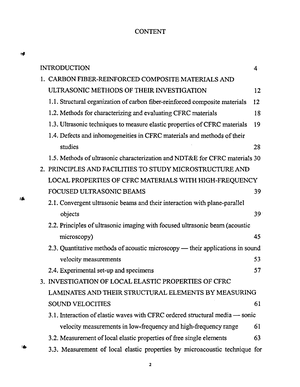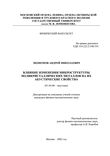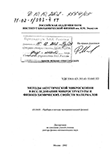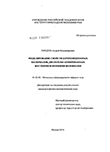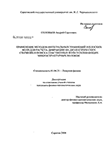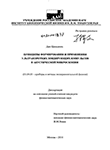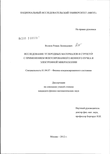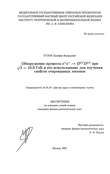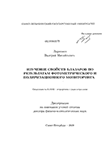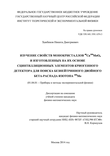Содержание к диссертации
Введение
1. Carbon fiber-reinforced composite materials and ultrasonic methods of their investigation 12
1.1. Structural organization of carbon fiber-reinforced composite materials 12
1.2. Methods for characterizing and evaluating CFRC materials 18
1.3. Ultrasonic techniques to measure elastic properties of CFRC materials 19
1.4. Defects and inhomogeneities in CFRC materials and methods of their studies 28
1.5. Methods of ultrasonic characterization andNDT&E for CFRC materials 30
2. Principles and facilities to study microstructure and local properties of cfrc materials with high-frequency focused ultrasonic beams 39
2.1. Convergent ultrasonic beams and their interaction with plane-parallel objects 39
2.2. Principles of ultrasonic imaging with focused ultrasonic beam (acoustic microscopy) 45
2.3. Quantitative methods of acoustic microscopy — their applications in sound velocity measurements 53
2.4. Experimental set-up and specimens 57
3.. Investigation of local elastic properties of cfrc laminates and their structural elements by measuring sound velocities 61
3.1. Interaction of elastic waves with CFRC ordered structural media — sonic velocity measurements in low-frequency and high-frequency range 61
3.2. Measurement of local elastic properties of free single elements 63
3.3. Measurement of local elastic properties by microacoustic technique for diverse kinds of CFRC material s 69
3.4. Measuring local elastic anisotropy of individual structural elements within CFRC laminate 75
4. Studies of bulk microstructure and defect NDE of CFRC materials by using microacoustic imaging technique 87
4.1. Specific features of ultrasound reflection and mechanisms of acoustic contrast in CFRC laminates 87
4.2. 3D Acoustic imaging method for CFRC laminates 94
4.3. Bulk microstructure characterization and structural flaw NDE of unidirectional CFRC laminates by using multiple types of acoustic imaging 98
4.4. Studies of bulk microstructure and small-sized defect NDE in multi-directional CFRC laminate 121
5. Bulk microstructure characterization of woven CFRC materials by using microacoustic imaging technique 143
5.1. Microstructural features of woven CFRC laminates and acoustic principles in their imaging 143
5.2. Studies of bulk microstructure of plain woven CFRC laminates by using multi-scanning acoustic imaging method 145
5.3. Studies of bulk microstructure of unidirectional tape CFRC laminate by using multi-scanning acoustic imaging method 160
Conclusions 169
Publications 171
References 172
- Ultrasonic techniques to measure elastic properties of CFRC materials
- Quantitative methods of acoustic microscopy — their applications in sound velocity measurements
- Measurement of local elastic properties by microacoustic technique for diverse kinds of CFRC material s
- Bulk microstructure characterization and structural flaw NDE of unidirectional CFRC laminates by using multiple types of acoustic imaging
Введение к работе
Carbon fiber-reinforced composite (CFRC) laminates belong to the class of reinforced composite materials whose elastic and strength properties are specified by properties of comprising components - resin matrix and reinforcement as well as spatial structure formed by reinforcing components in the matrix body. CFRC laminates consist of microscopic plies (100 - -150 (im). Plies are formed as ordered structure of carbon threads (carbon fiber bundles) in the form of sheets of carbon fiber prepreg produced by parallel packing of threads or carbon fabrics produced by weaving carbon threads. The sheets or wefts are impregnated with resin. Mechanical properties of CFRC materials are distinct from properties of the components - matrix and carbon fiber, and are prescribed by material structure. Diverse versions of reinforcing fiber ordering result in variations of mechanical properties in a wide range. By significant amsotropy of carbon fibers and big difference in elastic characteristics of isotropic resin and anisotropic fibers CFRC laminates possess high elastic anisotropy. Anisotropy depends on carbon fiber orientation, kinds of packing carbon bundles within each ply, fashion of ply stacking in laminate structure - due to type and mutual orientation of comprising plies.
Promotion of fiber-reinforced composites has opened a way to theoretical design of construction materials with prescribed properties. Studies in mechanics of composite materials -establishing principles of generation of elastic and strength properties by m eans of controlled ordering of reinforcing fibers; finding interrelation between properties of structural units, their arrangement and mechanical properties of an entire composite, studying disruption and flaw generation should be based on efficient methods of mechanical measuring and bulk structure investigation. Plentiful fields of practical application demand for efficient methods of non-destructive evaluation of CFRC laminate microstructure and properties, methods of high resolution flaw detection to reveal small-sized defects in the body of a materia] or article.
There is a wide set of research methods to study structure and properties at the face of CFRC laminate specimens - light microscopy, electron and probe microscopy, X-ray imaging technique, etc. But these methods are non-effective for studying bulk microstructure within the specimen body, which is fundamental for reinforced materials. Spatial arrangement of structural elements -carbon fiber, fiber bundles, threads and thread tapes; can be distinct within different layers in a ply stack. Occurrence of interlamina adhesive layers, resin pockets and headen flaws - interlamina defoliation, voids, microcracks; are typical for CFRC laminates. Ultrasonic techniques are a powerful instrument for structural feature investigation in CFRC materials and for quantitative characterization oft heir e lastic p roperties. U ltrasound p enetrates fairly deep і nside t he С FRC laminate body. Reflected or transmitted radiation can be employed for measuring velocities of diverse acoustical modes (bulk and leaky surface ones) or for imaging bulk material structure and visualizing flaws within the body.
Peculiarities of elastic wave propagation through structured matter depend on interrelation between the wavelength and characteristic sizes of structural constitutes. Aims and tasks of ultrasonic technique applications define an ultrasonic frequency range to be employed. At frequency lower than 10- -20 MHz ultrasonic wavelength substantially larger than characteristic sizes of CFRC laminate structural elements - plies, bundles and so on. Ultrasound is not sensitive to microstructural component presence - CFRC laminate is perceived by ultrasound as uniform generally anisotropic structured medium. Long-wave techniques in this frequency range are commonly used for measuring elastic and viscous parameters of CFRC laminates and in industrial NDI for revealing large-sized defects.
At higher frequency 50 • 100 MHz the CFRC laminate is perceived as a system of uniform anisotropic layers. Ultrasound reflects and refracts at interlamina interfaces. Ultrasonic radiation at these frequencies can be employed for characterizing structural units of the laminate - plies, carbon fiber bundles, carbon threads, tapes, etc. High-frequency focused ultrasonic applications for local measuring including elastic property characterization for particular structural elements. Data on elastic properties of structural elements together with integral characteristics of the composite as a whole make it possible to establish interrelation between material microstructure and elastic properties.
Scanning the focused beam over the specimen face and recording the reflected signal at each point of the scanning area allows to form acoustical images of the specimen bulk microstructure (scanning acoustic microscopy). Employing ultra-short (1-5-2 oscillations) probe signals is a way to visualize specimen microstructure both on the specimen face and at definite depth within its body. The technique makes it possible to view layer-by-layer microstructure of laminates, to estimate nature and types of defects, their distribution within a particular ply or in the body of laminate material as a whole. Methods of high-resolution acoustic vision demonstrate unique potentialities to get information on bulk microstructure in nonransparent matter, so development of the technique to be applied to CFRC laminate is a topical problem.
As CFRC materials are more widely used, the need of advanced and nondestructive characterizing techniques is becoming critical for measurement of material properties, observation and characterization of microstructure, study of failure modes and NDT&E of defects, ensuring reliable level of performance in both materials and structural uses. Ultrasonic technique provides opportunity to non-destructive evaluation and characterization of CFRC materials, including reconstruction of elastic constants, visualization of microstructure and evaluation of defects. Previous investigations were mainly focused on the applications of low-frequency limit:
(1) In measurement of elastic properties the ordered structural CFRC material laminates were treated as uniform structured medium by ultrasound because the employed ultrasonic wavelength was essentially larger than characteristic sizes of their structural elements. The elastic properties e xtracted from d ata о f p hase v elocities a re і ntegral v alues о f С FRC m aterials a s a whole.
(2) Acoustic imaging did not involve any contrast resulted from ultrasonic reflection at individual microstructure elements of CFRC materials because of limitation of spatial-resolution and no time-resolved reflections from individual structural elements and interfaces of neighbor plies. Although the surface microstructure of CFRC materials could be observed by traditional optical, electronic, etc. microscopy, they are of destructive methods.
(3) The investigations on nondestructive testing and evaluation (NDT&E) of CFRC materials were mainly attracted to the studies of large-scale defect detection and evaluation, which were caused deliberately under loading, such as delaminations, damages, matrix cracks, etc.
Therefore, (1) anisotropic characteristics of local elastic properties of CFRC materials and their structural elements is to be investigated; (2) methods for observation and characterization of bulk microstructure inside CFRC material laminates are to be developed; (3) evaluation and characterization of natural structural flaws and small-sized defects and their morphology and topology in CFRC laminate body are to be studied. In addition, previous investigations on ultrasonic characterization of CFRC materials were primarily attracted to carbon Mber-reinforcedVepoxy resin composites. The ultrasonic evaluation and characterization of carbon fiber-reinforced/bismaleimide resin composites are to be investigated.
[Aims]: The dissertation is aimed at:
- studying interaction of pulse high-frequency focused ultrasound with ordered composite media using CFRC materials as an example;
- development of principles to apply impulse high-frequency focused ultrasonic radiation for characterization of microstructure and elastic properties of ordered CFRC materials and their structural elements;
- generation of new and efficient ultrasonic methods to visualize bulk microstructure of CFRC laminates including carbon fiber bundles (threads) orientation within plies, distribution of polymer resin over the material body, quality of adhesive films between prepreg or fabric plies;
- development of new acoustic microscopy techniques for non-destructive evaluation of CFRC materials including detection of macro- and microflaws, revealing their topology and distribution over the specimen body. [Ngyelries]: All results given in the dissertation are novel.
High resolution ultrasonic technique for microstructure characterization in ordered composite media have been originally developed. The technique is based on employing small-aperture high-frequency focused ultrasonic beams.
For the first time interaction of ultra-short pulses of focused ultrasound with layered structures has been investigated. Echo signal formation at interfaces of different types within the CFRC material body has been studied.
For the first time the microacoustical technique based on using short pulses of high-frequency focused ultrasound has been employed to measure local values of longitudinal elastic wave velocity for different orientations of CFRC laminates including propagation velocity measuring along individual plies within ply stacks in the laminate materials.
For the first time sonic velocity values in different directions have been measured for individual carbon fiber microplies, and anisotropy of the individual plies has been estimated.
For the first time mechanisms of imaging diverse details of bulk microstructure in CFRC laminates have been found. Principles for displaying carbon fiber packing within individual plies of t he 1 aminate, for і maging і nterply adhesive і nterfaces, for d isplaying і nhomogeneous r esin distribution over the material body have been determined.
For the first time principles of revealing structural defects (ply bucklings and folds, non-uniform resin distribution, interlamina delaminations, etc), voids and inclusions in the body of CFRC laminate structures have been proposed.
[Significance for practical applications]: Results of the researches demonstrate high efficiency of small-aperture high-frequency focused ultrasonic beam application to non-destructive evaluation of elastic properties and microstructure of CFRC laminate materials. The results provide the basis on high-resolution microacoustical method application in researches as well as for industrial NDE and NDI. The most important results for practice are: technique for characterization of local elastic properties and anisotropy of diverse CFRC materials; methods of acoustic imaging bulk microstructure of CFRC laminates and principles of acoustic image interpretation; methods for visualization and classification of flaws that are typical for different CFRC materials.
rVolume and structure!: The dissertation includes introduction, five chapters (two first are summarizing ones). 176 pages, 90 figures and 17 tables are involved into the dissertation. List of references involves 53 items.
ГМаіп points of dissertation!: The dissertation is aimed at investigating interaction of high-frequency and ultra-short ultrasonic pulse waves with ordered structural CFRC laminates and studying possibilities of application of microacoustical method, which is based on the high-frequency ultrasound by employing lower aperture focused convergent probe beam, for CFRC laminate structure and mechanical property estimations as well as NDE of structural flaws and small-sized defects. The time-resolved reflection method and mechanisms of acoustic contrast based on propagation of the high-frequency ultrasound in CFRC structured media have been applied:
(1) to measure local elastic properties and elastic anisotropy of CFRC laminates and their individual structural elements;
(2) to observe and characterize bulk microstructure of CFRC laminates, including packing of fiber bundles and plies, topological features of structural ordering, configuration of weft and resin pocket in woven plies, perfection of interlaminar interfaces and geometrical nature of interlaminar layer.
(3) to nondestructively evaluate structural flaws and morphology of defects in diverse CFRC material laminates -including unidirectional, bidirectional and multidirectional laminates as well as woven laminates, by means of multiple types of ultrasonic imaging: successive series of C-scan and 5-scans imaging.
[Description of contentl: Chapter 1 includes a review of structural organization of CFRC laminates, their mechanical properties and ultrasonic methods - including the methods for studying elastic properties, microstructure as well as NDE of defects, being in use now to characterize the materials. Section 1.1 contains the basic knowledge on generation principles and structure of CFRC laminates. Ordered structures of carbon fiber bundles or threads resulted from one-layer parallel packing or weaving carbon bundles (threads) and impregnation of the structure by resin subsequent give rise to carbon prepreg plies or carbon fabrics. By the mechanical treating (curing) stacks of such plies finally form laminate composite materials possessing unique elastic and strength properties. Classification of carbon fiber bundles arrangement within a particular ply as well as of ply stacking into a laminate matter is given in section 1.1. A short discussion about methods for characterizing and evaluating CFRC materials is given in section 1.2. Review of ultrasonic techniques that are in use for measuring elastic wave velocities and elastic moduli of CFRC materials is given in section 1.3. Discussion is focused on immersion methods, including the double trip technique and line-focus beam application for measuring velocities of surface and bulk elastic wave modes. The review involves description of the direct measuring technique based on laser excitation of the probe ultrasonic spike. Techniques with using surface and waveguided modes to measure CFRC elastic properties are described as well as resonance methods.
Besides measuring elastic properties ultrasonic beams are employed for flaws detection within nonransparent CFRC materials. Section 1.4 includes classification of main types of structural imperfections in carbon fiber composites - inclusions, voids, cracks, ply bucklings and folds, thread ruptures, etc. Influence of the imperfections on mechanical properties of matter is under discussion. Section 1.5 contains a review of ultrasonic visualization methods that are in use for NDI of CFRC laminate materials. Ultrasonic NDI technique is compared with other methods of flaw detection. A short discussion about previous studied methods and their limitations is involved in the last part of this chapter.
Chapter 2 describes experimental technique and facilities that have been in use for high-frequency ultrasonic visualization (acoustical microscopy), principles of the visualization as well as methods of application of short pulses of focused ultrasound to measure local values of elastic characteristics (microacoustical technique). To ultrasonically characterize local properties, microstructure and small-sized defects of CFRC laminates, section 2.1 is aimed at analysis on convergent ultrasonic beams and their interaction with plane-parallel object. The general principles of ultrasonic imaging surface and bulk microstructure by employing different focused ultrasonic beams are discussed in section 2.2. It contains three parts - ultrasonic focusing systems with low- and high-aperture, distinct probe signals (in harmonic systems, short-pulse ultrasonic signals), object surface and bulk microstructure imaging by using high and low-aperture focusing systems. Three possible quantitative methods for measuring elastic properties of CFRC materials based on acoustic microscopy are discussed in section 2.3. The microacoustic technique is powerful means to evaluate microstructure and mechanical properties of CFRC materials present-day because of its high resolution and penetration abilities. The last part of the chapter is given to descriptions of experimental set-up and CFRC material specimens to be used for the studies.
Chapter 3 is devoted to the studies of local elastic properties of different types of CFRC laminates and their structural elements by measuring sound velocities. Interaction of elastic waves with ordered structural CFRC media - sonic velocity measurements in low-frequency and high-frequency cases, is discussed in section 3.1. The theoretical analysis shows that the effective sonic velocities of the composite material are different in the short-wave and long-wave limit cases when layers possess different densities and sound velocity values in CFRC laminates. Section 3.2 is given to measure elastic properties of free single structural elements - including matrix materials (pure resin plate), a single ply with adhesive layer and without adhesive layer cases, by using the established experimental set-up. The measurement of local elastic properties of diverse kinds of CFRC materials - unidirectional, bi-directional, multi-directional and woven CFRC laminates, by using the microacoustic technique is the aim of section 3.3. The experimental and theoretical comparison of sonic velocities obtained in high-frequency and low-frequency limits is given in this section too. The anisotropic characteristics of individual layer in cross-ply CFRC laminate are studied in section 3.4. Sonic velocities have been measured in different directions of fibers - across plies, along fibers and across fibers in individual layers. The detailed experimental results and discussions are given in this chapter-Chapter 4 is dedicated to the development of microacoustic imaging technique for studying bulk microstructure and structural flaws in the body of diverse prepreg-based CFRC laminates. Section 4.1 involves discussions on mechanisms to form acoustic images of diverse elements of internal microstructure in CFRC laminates. Feasibility to visualize particular structural elements and different types of faults in the CFRC laminate specimen body has been assessed. Section 4.2 gives the details of the special microacoustical technique aimed at high-resolution acoustic imaging CFRC laminates. Tomographic operation mode is employed to produce 3D acoustic images of CFRC laminates. Section 4,3 and 4.4 are focused on the application of the devising acoustic vision technique for high-resolution non-destructive evaluating microstructure and faults in diverse CFRC laminates with various topology of ply packing. The main concern is with principles of acoustic imaging interpretation based on primary mechanisms of acoustic contrast for CFRC laminates that have been considered in section 4.1. A plentiful of experimentally studied results with detailed discussions is exhibited in this chapter.
Chapter 5 is focused on the studies of bulk microstructure of woven CFRC materials by using the established microacoustic imaging technique. Section 5.1 is given to description of microstructural features of woven CFRC laminates and mechanisms of acoustic contrast for imaging their bulk microstructure. Section 5.2 and 5.3 are devoted to studies of bulk microstructure of plain woven and unidirectional tape CFRC laminate by using the acoustic imaging method. Mechanisms and interpretation of acoustic imaging microstructure in woven CFRC laminate body are discussed in details based on effective ultrasonic reflections at structural elements. A wealth of experimentally studied results with detailed analysis is involved in this chapter.
Conclusions of the studies in this dissertation are represented after chapter 1 to chapter 5. [Publications]: Dissertation content is reflected in 9 publications and two papers to be published in journal Ultrasonics and Composites (Part B), as listed in the publications the dissertation.
[Personal contributions]: Work has been performed at the laboratory of acoustic microscopy, Institute of Biochemical Physics, RAS and at Beijing Aeronautical Manufacturing Technology Research Institute (B AMTRI), People s Republic of China under supervision of V.M. Levin, Ph. D., the head of the laboratory. The problem of imaging diverse microstructural peculiarities in CFRC laminates has been put by the author himself. The author studied principles of acoustic image formation in structured CFRC media. The author proposed classification of structural flaws typical for carbon fiber composites. The author participated in studying microstructure of CFC m aterials by о ther techniques including light microscopy methods, He developed methods of local characterizing elastic anisotropy of CFRC laminates and performed measuring local elastic properties. His contribution to publications prepared in cooperation with other authors is not less than a half.
Approval of the workl: Results have been reported at scientific seminars, the N. M. Emanuel Institute оf В iochemical Physics (Moscow, Russia, April-June, 2 001), at e very-year competition for the best scientific research work, BAMTRI (Beijing, China, September 2002), at MRS Fall Meeting (Boston, USA, November 2002), at 27th international conference on ultrasonic visualization "Acoustical Imaging, 27" (Saarbriicken, Germany, March 2003), at 8th National Conference on NDT&E (Su Zhou, China, September, 2003), at every-year competition for the best research work, N. M. Emanuel Institute of Biochemical Physics (Moscow, Russia, March, 2004).
Ultrasonic techniques to measure elastic properties of CFRC materials
Carbon fiber-reinforced composite (CFRC) materials are ordered structures of carbon-fiber reinforcing elements that are embedded into polymer matrix. CFRC materials possess complicated, multi-level spatial organization. The main ingredients of these compositions are carbon fibers and resin binder. Variety of CFRC materials is caused by distinctions in ways to arrange the carbon constituents and variations in properties of fibers and resin.
Strength and elastic characteristics of carbon fibers depend on their precursor and processing condition[W1. There arc two types of carbon fiber precursors - polyacrylonitrile (PAN) fibers and mesophase pitch. PAN-based carbon fibers possess high tensile strength and resistance to compressive failure; pitch-based fibers are characterized by high values of elastic modulus. The difference in mechanical properties results from distinct nanostructure of single fiber. Diameter of a single PAN-based fiber is of 8 - 12 um, whereas diameter of a single pitch-based carbon fiber is much bigger up to 60um. Fibers are picked up into mesoscopic structural elements - fiber bundles and threads.
A few types of polymer resin - epoxy, bismaleimide, polyimide and others, are in use as a binder. Single fibers or single resin are not useful for real application. Only when they are properly mixed together, desired properties can be reached. First step in fiber-resin arrangement is picking up carbon fibers into initial structural elements - fiber bundles or threads. Impregnated by resin, bundles or threads are the main construction units to build reinforcing structures. Next level of spatial construction is two-dimensional packing bundles or threads into macroscopic construction elements — prepreg plies or carbon fabrics. A single-layer prepreg sheet (ply) is produced by tight parallel packing of fiber bundles linked between them due to resin adhesion. Carbon fabrics are formed from fiber bundles and threads by means of special weaving process. Figure 1-1 is the illustrations of basic material components and structural elements in CFRC laminates.
Finally CFRC laminates are fabricated by stacking prepreg plies or fabrics with prescribed sequence of bundles (in prepreg plies) or weaving (in fabrics) orientation by means of curing and other special kinds of technological processes. Depending on primary components of laminate structure, three main classes of CFRC materials are developed for industrial application (as sketched in Fig. 1-2): - Prepreg ply-ply laminates based on stacking single-layer prepreg sheets with diverse mutual orientation of ordered bundles in neighbor layer: 1) unidirectional laminates that possess the same bundle orientation in all layers of the stack; 2) bidirectional ones including cross-ply packing with orthogonal orientation of fibers in neighbor laminate and 3) multidirectional laminates. The ordered structure of ply-ply laminates is described by the abbreviate form: where а, Д, y, — mean orientation directions of carbon fibers of successive laminae: 0, 90, ±45 and so on, within each period of successive stacking; s means occurrence of the symmetry plane of stacking and и - number of structure periods on each side from this plane. So the notation [0 / 90]2( means cross-ply packing of 8 plies that are arranged symmetrically with respect to the median plane of this packing. - Woven laminates are formed by parallel packing carbon fabric plies, tapes or mates. So initial classification of woven composites comes from kind of a matter to be used as layers of stacking. The most important and widespread kind of woven laminates are materials formed by stacking carbon clothes of diverse weaving. So the next step of woven laminate classification is a type of weaving - plain, serge or satin. Finally, the classification has to include information on number of layers and mutual orientation of two-dimensional networks in successive plies. - Stitched composites that are ply-ply or woven CFRC laminates reinforced by throughhickness stitching by means of special fiber yarn to enhance interlaminar damage tolerance of CFRC materials. Enhanced interlaminar shear strength properties make stitched composites to be more and more attractive for future applications. So CFRC laminates are multi-level hierarchy structures; every level of it is characterized by specific sizes of structural elements. The smallest elements of the hierarchy are single carbon fibers; their diameter is in the range of 8 + 12 цт (PAN-based fibers). Size across a fiber bundle is close to single ply thickness A( 120-j- 130/ш; width of bundles usually exceeds essentially their thickness. The final geometrical characteristics of CFRC laminates are specimen thickness and total number //of layers in a ply stack. Usually this quantity is changed in the range from N= 2 up to N= 200 (or more); respectively the total thickness of CFRC specimens is inside the range of 0.2 - 20 mm. Summary of specific sizes of characteristic structural elements is given in table 1-1. The main target of fiber reinforcing is control of mechanical properties of structural materials. Response of a structured matter to mechanical loading is derived both spatial arrangement of structural elements and mechanical characteristics of its primary ingredients - polymer resin and carbon fibers. Polymer resins that are in use as a matrix material are isotropic with rather high values (for polymers) of elastic moduli - bulk modulus K= (6 -10) GPa and shear modulus G = (2 -s- 4) GPa. A single carbon fiber possesses graphite-like structure. Crystalline graphite is parallel stacking of hexagonal atomic planes formed by means of strong covalent sp bonding of carbon atoms. These graphite atomic planes have had a special name — graphene sheets. Atomic planes interact between them with molecular Van-der-Waals forces. Finally crystalline carbon demonstrates the hexagonal structure with C-axis perpendicular to graphite atomic planes. This atomic construction results in high anisotropy of the matter response to mechanical loading and, respectively, g reat v ariations о f e lastic m oduli d epending о n d irection о f a 1 oad. R esponse о f graphite to loads that induce changing atomic array in covalent atomic planes, is characterized by extremely high values of in-plane elastic moduli: Cn- 1060 GPa, C12= 180 GPa, CM = 450 GPa . Resistance to changes of the interplane distance is coming from Van-der-Waals forces added interaction of negative charge layers formed by valent ж -electrons on both side of each atomic sheet. This combined interplane interaction is effective enough - elastic moduli C3J and C13 that described elastic response to load across atomic planes stacking, close to standard values typical for the most of substances: C33 = 36.5 GPa, Cl3 = 15 GPa[5]. Only the elastic matrice component
Сф, responsible for interplane shear takes the unusually low value: CM= 0.2 + 0.8 GPa \ Full set of elastic moduli characteristic for graphite is given in table 1-2.
Carbon fibers consist of graphene atomic sheets or its fragments. Sheets are very labile - they can take diverse curved shapes. There are a few versions of graphite - like arrangement of graphene-sheet elements in carbon fibersI6] — concentric packing of cylindrical graphene shells, radial packing of plain graphene sheets, random texture formed by graphene sheet particles that are aligned along the fiber axis with random distribution of their "in-plane" orientation and so on. But in any case, plain or curved graphene sheet elements are oriented parallel to the fiber axis - a nonnal to surface of these elements will be perpendicular to the fiber direction. Such alignment of graphene sheet elements provides structure of carbon fibers, suitable to get high values of both the tensile modulus (EF 200 + 600 GPa) and the tensile strength (CTF 3 5 GPa). For such arrangement of material components reaction of a fiber to a tensile load is derived by the in-plane elastic modulus Cn of graphite and in-plane strength of graphene sheet.
Quantitative methods of acoustic microscopy — their applications in sound velocity measurements
Ultrasonic technique is widespread method to measure sonic velocities and elastic moduli of CFRC laminate materials. Experiments are usually performed with ultrasound of relatively low frequencies to provide ultrasonic wavelength being substantially bigger than characteristic sizes of structural elements. At frequencies below 10 +-15 MHz CFRC laminates are perceived by ultrasound as a uniform structured matter. For such frequencies ultrasonic measurements give macroscopic integral values of elastic characteristics of the composite material as a continuous medium. The same low-frequency range of ultrasonic frequency has been used to visualize large-scaled defects induced in the CFRC laminate body by mechanical (usually, impact) loading. Occurrences of laminate fibrous mesostructures result in expressed elastic anisotropy of CFRC laminates, background (Rayleigh) scattering at structural elements and traditional ultrasonic attenuation stemming from this scattering. Data from sonic velocities, elastic anisotropy, ultrasonic attenuation and background scattering are employed for characterization of microstmctures, nondestructive detection and evaluation of defects in the CFRC materials.
In low frequency limit case sound velocity is derived from the effective elastic modulus of the structured medium. The neighbour layers are in the uniform stress field. The elastic constants CiJk} of an anisotropic material can be determined by measuring phase velocities up of ultrasonic bulk waves propagating in it according to the Christoffel equation. where nt is a unit vector in the direction of wave propagation, and p is density of material.
For a symmetry anisotropic media, the elastic constants reduce to nine independent elements in the stiffness matrices [c J or compliance matrices [SIJkJ \ . Usually, CFRC materials can be treated as orthotropic symmetry media. Thus, the elastic properties of them can be reconstructed from the nine independent elastic constants. According to Christoffel equation (1-1) and stifmess matrices ]CjJ!d J, the full set of elastic constants С, ы of CFRC materials can be reconstructed from phase velocity measurements. Theoretically, for a symmetrical anisotropic material, seven of the nine elastic constants Cn, Cl2, CI3, Сг1, CJ2, C2i, C33, C , CiS and Си can be formed from the phase velocity measurements in two symmetry planes by using ultrasonic immersion method in these two planes. M. F. Markham and R. E. Smith are the pioneers of this measuring method [7, \ S. I. Rokhlin and his group had successful investigations in immersion method[9 131. Recently, Vadim M. Levin has a detail analysis for the correctness of this measuring method, theoretically and physically.
High anisotropy of CFRC materials, which is resulted from evidently difference in elastic properties of their primary material components fiber and resin, and design based on stifmess of composites, have attracted a great deal of attentions on the measurement of elastic properties of CFRC materials. In the measurement of elastic properties of CFRC materials ultrasonic methods are more precise and accurate . Compared with the traditional static measuring methods, a major advantage is it can be conducted in different directions in a specimen, and several, even full elastic constants, can be measured in a specimen 9_14 Furthermore, the information about microstructure and defects inside the CFRC materials can be extracted and visualized from the data of ultrasonic measurements. For examples, one can reconstruct elastic constants and characterize rnicrostructures from data of phase velocity measurements of different wave modes and background scattering in composite materials [9 U]. Currently, several sonic velocity measurement methods have been developed for reconstructions of elastic properties of CFRC materials, nondestractively, when one or two sides of the specimen to be measured are accessible. These methods include double throughransmission immersion method in symmetry plane and non-symmetry plane, immersion methods by using focused beam, and some other miscellaneous methods for sonic velocity measurement І7"гЧ Among theses approaches ultrasonic immersion method is one of them widely used for sonic velocity measurements in the characterization of elastic properties of CFRC materials. Double throughransmission immersion methods
The phase velocities of three wave modes - a quasi-longitudinal and two quasi-shear waves, can be measured by using double throughransmission in a symmetry or non-symmetry planes of CFRC materials, as іllustrated іn figure 1 -3. The authors in literature [9-13] had a successful investigation and represented their measurements of elastic constants of graphite/epoxy CFRC unidirectional composite laminate. In their double throughransmission immersion methods a low frequency ultrasonic wave based unfocused beam was employed. In the early years, fluid path reference was used in the double throughransmission method, as illustrated in figure 1 -3(a). The probing ultrasonic waves from transducer transmit through the specimen, reflected by a plane reflector behind it, and finally transmit through the specimen again along the same acoustic path as the і ncident w aves t о t he t ransducer. T he p hase v elocities can b e extracted b у m easuring t he time-of-flight difference between the doubly transmitted signal t(9,) through the acoustic path with the specimen and the doubly transmitted signal tg without the specimen (Fig. І-За)112 13 . As an improvement of this velocity measurement approach, a self-reference method was used in their late investigations on elastic properties of CFRC materials, as illustrated in figure l-3(b). The specimen to be measured is acted as a reference acoustic path, instead of the fluid path in figure 1-3 (a). In this method the sonic velocities of fluid and the specimen at normal incidence are measured firstly. Then, one с an m easure t he p hase v elocities і n d ifferent r efraction a ngles b у rotating the specimen.
A comparison of the measurements by the two methods was given by Y. С Chu and S. I. Rokhlin i0 . Their measured phase velocities of quasi-longitudinal wave had a little difference nearby the normal incident angles. The values of their measured phase velocities of quasi-longitudinal wave, quasi-shear waves were changing in the range of 3 -8 km/s and 2.5 - 2.9 km/s respectively while increasing the refraction angles from 15 to 60. The specimen was graphite/epoxy composite unidirectional laminate. In graphite/epoxy unidirectional composites the Cu and Cw are not measurable using an immersion method in two symmetry planes because an SH wave polarized in the pane of the composite plate 1-2 plane in figure 1-3 could not be excited from fluid in the 1-3 and 2-3 planes. Thus, resulting in the measurable quasi-longitudinal and quasi-shear waves were independent of Cu and CM. So the authors in [9] reconstructed Ci2 and C by measuring the phase velocities in non-symmetry planes, as illustrated in figure l-3(c). The propagation plane was tilted by an angle Ф from the materials plane (1-3) along the fiber direction. The waves propagate along the axis 3 at a refraction angle 9 in the tilted plane. The axis 1 was in the plane. It contained axes 1 and 3 , and didn t lie in the propagation plane. The axis 2 was perpendicular to the 1, Г and 3 axes. In non-symmetry plane, the incident plane had an angle with the fiber direction. The three waves (one quasi-longitudinal and two quasi-shear waves) can be excited. A 5 or 6 MHz frequency transducer was employed in their measurement, A detailed analysis at Ф = 45 was given in [9]. It is worth noting that in this method the actual measurement from time-of-flight corresponds to group velocity in CFRC specimen, but S. L Rokhlin[13] and Vadim M. Levin, etc. have demonstrated the correctness - the sonic velocity extracted from the measured time-of-flight is equal to phase velocity in CFRC specimen.
Measurement of local elastic properties by microacoustic technique for diverse kinds of CFRC material s
Ultrasonic pulse-echo method, transmission-reflection method and back scattering method, etc., have been applied to NDT&E for CFRC materials, as illustrated in figure 1-6. The literatures on ultrasonic NDT&E of CFRC materials are abundant. Apart of them listed in the references. In [34] H. Kaczmarek investigated the detection ability to transverse cracks and ply delamination in CFRC materials by means of ultrasonic methods. In their study, ultrasonic throughransmission mode (Fig. l-6a) was used to detect transverse cracks, and pulse-echo mode (Fig. l-6d) was employed to inspect ply delamination in CFRC materials. A pulse with width adjustable from 80 to 450 rts was applied to a 20 MHz frequency focusing transducer to generate and receive ultrasonic waves. The ТЗ 00-914 (fiber 62%, voids: 1%) bidirectional CFRC material specimen was conducted by multiple C-scan imaging. Different acoustic scanning images could be obtained during scanning by means of automated shifting sequence gate. Their experimental results showed that the transverse cracks and ply delaminations could be found by the employed ultrasonic method. However, the minimum width of electronic gate for multiple C-scan imaging was 85 ns -approximately corresponding to 0.14 mm in thickness of specimen. The ultrasonic probing pulse duration w as 2 00 «.s - a pproximately с orresponding t о 0.33 m m t hickness s lice о f t he С FRC material specimen. In our concerning CFRC material laminates the thickness of a single prepreg ply is approximately 0.12 - - 0.13 mm. Thus, it is difficult to obtain images of a single ply slice due to lack of enough high spatial resolution.
F. Aymerich and S. Meili studied the detection of delaminations and matrix cracks caused by low-energy (3.6 and 5 J) impacts in CFRC material laminate by using ultrasonic pulse-echo techniques[35]. C-scan imaging technique, based on time-of-flight and amplitude of pulse-echo signals, was used in their investigations. Normal incident pulse-echo mode was applied to detect ply delaminations, and backscattering mode at a proper incident angle was used to find matrix cracks!35 (Fig. l-6d). The specimens were from CFRC panels - consisting of 16 pies ([0/±45/90]2S, 2.2 mm thickness). Matrix was polyetheretherketon (thermoplastic resin). The thickness of a single ply was 0.125 mm. A 22 MHz frequency focusing transducer (3.2 mm in diameter, 18 mm focal distance) was employed. The oblique incident angle was selected to 26 for imaging of matrix cracks in different layers of the specimen [351. Their results showed inter-ply delaminations and matrix cracks caused by low-energy impacts could be found by the C-scan imaging. A high-resolution image of matrix cracks could be obtained by using a narrower electronic gate, for example 50 ns. But the C-scan images were blurred when a wider time gate, such as 300 ns, was set. For an unknown depth of defect it required a careful choice of location and width of the time gate. When the ultrasonic back scattering imaging method was employed, a proper oblique incident angle selection is essential for finding the matrix cracks in layer of specimen to be detected, because usually the matrix cracks were along directions of fibers. The fiber breakage in the 0 and 45 plies at the back surface of the specimen could not be found in their experiments because of the limitation of spatial resolution. The authors in [41 ] also conducted an investigation aiming at detection of micro-cracks matrix in a 1 б-ply T300/520S graphite/epoxy CFRC specimen ([90A/OA]S). C-scan and B-scan imaging, based on pulse-echo and back scattering modes, were arranged to the specimen. 10 MHz and 22 MHz focusing transducers (25 mm focal distance) were employed. Their results demonstrated that the high frequency ultrasonic waves based on focused beam was the possible way for a better imaging of deliberately thermally micro-cracks in the CFRC material specimen. In [42, 43] the authors employed ultrasonic C- and 5-scan imaging techniques to detect delaminations in three kinds of CFRC material specimens: 1) carbon/epoxy (A94/3501-6), [0/±45/90]2s 16-ply quasi-isotropic laminate with delaminations by embedding Teflon film patches inside it; 2) 200-ply unidirectional 25 mm thick laminate with delaminations by embedding Teflon film patches inside it also; 3) [0/-45/90/45]js 16-ply quasi-isotropic laminate subjected to low-energy impact of a 200 g impactor from a high 1.8 mm. Pulse-echo mode (Fig. l-6d) was used to detect the defects in the thin specimens (16-ply) by using ultrasonic focused beam. A throughransmission method (Fig. 1 -6b) was applied to detect the deliberate delaminations in thick specimen (200-ply, 25 mm). Unfocusing transducer was used to transmit ultrasonic signal, focusing transducer was employed to receive the throughransmitted signals, as illustrated in figure l-6(b). Although the employed frequency (5 -15 MHz) of ultrasound was lower compared with the frequency employed in [34, 35], their results - the C- and 5-scan imaging, demonstrated ultrasonic detectabilities for these large deliberate delaminations and impact damages.
To improve the resolution of ultrasonic NDT&E imaging, some previous literatures attempted to employ image enhancement and processing techniques. Authors for example in [44,45] tried to improve quality and resolution of ultrasonic C-scan imaging for NDE of matrix microcracks in carbon fiber-reinforced/epoxy composites by using image enhancement techniques. Nevertheless, the improvements were very limited according to their results because oflow original resolution.
Another important application of ultrasonic NDT&E for CFRC materials is detection and evaluation of flaws in fabrication. For examples, in [46] David K. Hsu and Michael S. Hughes investigated the NDT&E of near-surface foreign objects in CFRC material laminates by using pulse-echo method (Fig. l-6d) oflow frequency ultrasound based focused beam. 1 MHz (2 inch focal distance), 2.25 MHz (4 inch focal distance), 5 MHz (2 inch focal distance and 4 inch focal distance) focusing transducers were employed in their experiments. Instead, peako-peak amplitude of the entire reflected RF signals - reflected from the front surface of the specimen, was used in producing C-image of the flaws in CFRC materials because no echoes from the near-surface foreign objects were time-resolved in the case of the low frequency ultrasonic pulse at normal incidence. The specimens were from 48-ply graphite/epoxy laminates (9.14 mm thickness) and 4 mm thick woven graphite/epoxy laminates. The specimens with 1 ply depth near-surface foreign objects - deliberately induced by embedding a 1/4 inch and 1/2 inch square 0.002 inch nylon bag materials or 0.002 inch Teflon, 0.004 inch polyethylene films, were imaged by conducting C-scan. Their results showed that the images of the deliberately induced near-surface foreign objects obtained by using 5 MHz focusing transducer were evidently better than the images obtained by using 1 MHz focusing transducer.
Bulk microstructure characterization and structural flaw NDE of unidirectional CFRC laminates by using multiple types of acoustic imaging
The summary of the measured longitudinal sonic velocities is given in table 3-6. The measured values of sonic velocities in different fiber directions of individual layers within the cross-ply CFRC laminate demonstrate the evidently acoustic and elastic anisotropy of them. The magnitudes of local sonic velocities (vL= 3.19 km/s) obtained in the case of wave beam propagating across layers (i.e. thicknesshrough direction of laminate) are close to values of the sound velocities (v,.= 3.04 -s- 3.22 km/s) across the free single prepreg and single prepreg embedded into adhesive films. However, they are much smaller than the values of sonic velocities (vLi - 6.49 и- 6.92 к m/s) a cross і n-Iayer fiber о rientation, t hough t he elastic w aves p ropagate across the fibers in both of the two cases. The measured local bulk sound velocities in neighbour layers with cross-directional fibers within laminate also show the markedly different magnitudes along fiber direction (vL2 = 8.98 -s- 9.17 km/s) and across fiber direction (oLt = 6.49 4- 6.92 km/s). The elastic anisotropic characteristics are also demonstrated from the measured velocities.
Table 3-7 gives us the reconstruction of elastic constants Cn, C22 and C33 from the data of measured sonic velocities in different directions of the sample by using the density (p = І.бО з) of the CFRC laminate. The evidently different values in Tab. 3-7 show the elastic anisotropy of the individual layer (plies). The elastic constants along (C„) and across (C22) fiber directions are evidently higher than the values of pure resin plate (table 3-2). But the elastic constant (C33) across plies is in the same amount order. In addition, the elastic constants reconstructed by S. Rokhlin[13] are also listed in table 3-7. It is worth pointing out that our data of elastic constants Cu and C33 are close to the values in [13], but C22 is big different The value of C22 in [13] is close to elastic constant of pure resin (see table 3-2). It is difficult to understand why the value of C„ is so small. signals reflected from individual neighbour layers with different fiber directions process distinctly delay times. Fixing electronic gate on the position of time-of-flight corresponding to the different reflected signals, we have opportunity to visualize the layers with the same fiber direction, for example the layer corresponding to Lj. Changing electronic gate to the position of time delay corresponding to L2, we have opportunity to image individual layers with another fiber direction.
Figure 3-15 gives the acoustic images of surface and bottom of the sample by using different electronic gates, as shown in figure 3-15(a). Figure 3-15(b) is the C-scan imaging of surface (7 of the sample by setting electronic gate to position of time delay corresponding to the echo signal F reflected from surface of the sample. The contrast in Те has demonstrated the anisotropy of individual layers: 1) the white stripes mean: higher reflection received in these areas -corresponding to the layers in which the probe beam propagates along fiber direction; 2) the darker stripes mean smaller reflection received in these areas - corresponding to the layers in which the probe beam propagates across fiber direction. This difference in ultrasonic reflections is resulted from elastic anisotropy of the cross-layer in the sample, as illustrated in figure 3-16. When the probe ultrasound impinges on the surface of the sample (water immersion), the reflection coefficient R\ (approximately R\ 0.76) in the case of fiber-cross direction is smaller than the reflection coefficient i?2 (approximately ЛЇ 0.82) in the case of fiber-parallel direction: Л Rzhat means more ultrasonic energy will be reflected on the surface of the layers with fiber direction parallel to the wave propagation direction. The elastic anisotropic characteristics have been shown by the measured data in table 3-6 and table 3-7. From the contrast in To, One can easily to find the profiles and packing of the layers in the sample: 16 layers (8 brighter stripes correspond to 8 layers of them, and 7 darker stripes correspond to other 8 layers of them - the wide darker stripe in the middle of TV corresponds to two layers because of symmetrical lay-up of the laminate).
Setting electronic gate to position of delay time of echo signal Li corresponding to probe beam propagating along fibers, it approximately gives the image of bottom of the layers with the same fiber direction - along the direction of probe beam propagation, as shown in figure 3-15(c). The darked stripes correspond to these layers. The occurrence of white stripes - corresponding to neighbour layers, between the darker stripes is resulted from the signal Lj. Because the front and bottom faces of the sample are not parallel to each other, signal Lj has opportunity to enter the very narrow electronic gate for imaging 7j. This interpretation will be supported by J5-scan. The wide white stripe in the middle of 77 corresponds to two layers as the interpretation of the wide darker stripe in T».
When electronic gate fixed to position of delay time of echo signal Li corresponding to probe beam propagating across fibers, it approximately gives the image of bottom of the layers with another fiber direction - across the direction of probe beam propagation, as shown in figure 3-15(d). The white stripes correspond to these layers. The C-scan image (Г?) resulting from echo signal Lj and L2 is given in figure 3-15(e) by fixing electronic gate to the position of delay time involving the two echo signals. One can find that the contrast in 7? is the summary of T] and T2, and can easily find profiles of the individual layers in the sample from the dark-white stripes. The white stripes in To correspond to dark stripe in T3. One may observe the bright spot indicated by the elliptical dotted line in T2 and T3. It is easy to find this white spot is only from the L2 or the reflection that has the same delay time with L2. It may be caused by the internal microstructure change or microdefect, for example local resin acoustic path, because brighter contrast means good reflection caused and received in the position of delay time.
By using electronic gate to the position of delay time involving F, Lj and L2, it gives 5-scan image of the sample, as shown in figure 3-15(f). The contrast in -scan image demonstrates the fast wave {Li) and slow wave (Lj). It also shows geometrical imperfection of the surfaces of sample. This is reasonable because the sample is cut from specimen No.6 without special surface

